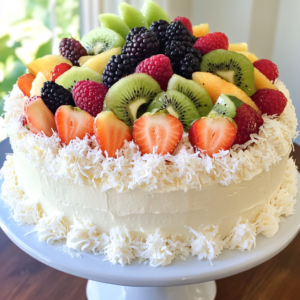Introduction
Craving something sweet and tropical? Coconut cake recipes are here to satisfy your taste buds! These delicious cakes combine the rich flavor of coconut with a moist, tender crumb, making them perfect for everything from birthday celebrations to casual weekend treats. In this guide, we’ll explore a variety of coconut cake recipes, including classic, vegan, and gluten-free options. You’ll also find tips on perfecting your cake with tasty frostings and tropical fillings. Ready to dive into these amazing coconut cake recipes? Let’s get started!
Introduction to Coconut Cake Recipes
What is a Coconut Cake?
Coconut cake is a moist, tender cake infused with the tropical essence of coconut, often topped with creamy frosting and garnished with coconut flakes. Traditionally, coconut cake is a Southern favorite in the U.S., but it has gained popularity worldwide for its unique flavor and comforting sweetness. Many recipes call for coconut milk, coconut cream, or shredded coconut, making each bite rich and flavorful.
Popularity and Cultural Significance
Coconut cake isn’t just a dessert—it’s a cultural staple in many regions. In the South, it’s common to see coconut cakes at family gatherings, holidays, and celebrations, adding a homemade warmth to any table. Coconut also plays a role in tropical cuisines, where it’s valued for its versatility and distinct flavor. Whether served for birthdays or casual dinners, coconut cake brings a bit of tropical sunshine to any occasion.
This delightful dessert has also adapted over the years, with modern recipes featuring vegan, gluten-free, and low-sugar variations. This evolution makes coconut cake accessible to everyone, allowing fans to enjoy it, regardless of dietary preferences or restrictions.
Essential Ingredients for Coconut Cake
Core Ingredients
When baking a delicious coconut cake, the core ingredients make all the difference in achieving that perfect balance of flavor and texture. Let’s break down what each ingredient brings to the table:
- Flour: The type of flour you choose can impact the cake’s texture. All-purpose flour works well for a tender cake, while cake flour can make it even lighter and fluffier. If you’re opting for a gluten-free coconut cake, consider using almond or coconut flour as alternatives.
- Sugar: Granulated sugar is the standard choice, though some recipes use brown sugar for added depth. Want to keep things low on sugar? Coconut sugar or a sugar substitute can work well without sacrificing too much flavor.
- Eggs: Eggs provide structure and help the cake rise. For a vegan coconut cake, you can replace eggs with applesauce, flax eggs, or other plant-based substitutes to maintain the moistness and consistency.
- Fats: Butter is a common choice, adding richness and enhancing the flavor. For a dairy-free or vegan twist, coconut oil is a fantastic alternative, and it complements the coconut flavor seamlessly.
- Leavening Agents: Baking powder and baking soda are key to a light, airy cake. Be sure to measure these accurately; too much can lead to an uneven texture, while too little can make the cake dense.
Coconut-Specific Ingredients
Here’s where the coconut magic truly happens! These ingredients are essential to achieving that rich coconut flavor:
- Shredded Coconut: Sweetened or unsweetened shredded coconut adds texture and an intense coconut taste. Sweetened coconut brings extra sweetness, while unsweetened has a more natural flavor. Both can work well, depending on your preference.
- Coconut Milk: This ingredient is a powerhouse in coconut cake recipes. It’s rich, creamy, and adds moisture, making each bite soft and flavorful. For a more intense coconut flavor, opt for full-fat coconut milk instead of the light version.
- Coconut Cream: Thicker and richer than coconut milk, coconut cream amplifies the flavor. It’s ideal for recipes where a dense, creamy texture is desired. Just be careful with the quantity—too much coconut cream can make the cake overly rich.
- Coconut Extract: To maximize the coconut taste, adding a few drops of coconut extract can do wonders. It enhances the natural coconut flavor without adding any texture, creating an unmistakable tropical note in every slice.
With these ingredients in hand, you’re ready to create a coconut cake that’s full of flavor, texture, and perfectly moist.





6 thoughts on “Coconut Cake Recipes: Classic, Vegan, and Gluten-Free Options”